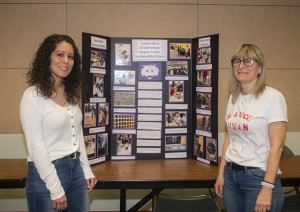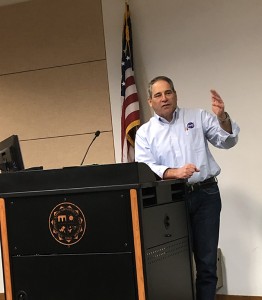CSUN Shows Off Early Returns of Sustainability and Climate Science Education in NASA Partnership
Elementary school students across Los Angeles are learning lifelong sustainable habits: choosing reusable water bottles, bringing their own utensils with their lunch or to restaurants, turning off the lights when not in use, even growing their own vegetables.

Photo by Christopher Caneda
These aren’t new ideas, but the momentum behind them is building this decade. The students — and their teachers — learned these tricks thanks to a partnership between CSUN and NASA’s Jet Propulsion Laboratory (JPL), who have offered workshops at CSUN and JPL, in Pasadena, to teach students about sustainability and grants to get projects started.
On Feb. 29, CSUN’s professor of education, Susan Belgrad held a showcase on campus for the elementary school projects, giving representatives from NASA a glimpse of the early returns from the partnership.
The participating schools were Magnolia Science Academy 7-Northridge; Vaughn Next Century Learning Center; Ranchito Avenue Elementary School; Victory Boulevard Elementary and STEAM Magnet School; Stanley Mosk Elementary School; Haskell Elementary STEAM Magnet Elementary School; Carpenter Community Charter; Castlebay Lane Charter Elementary School; and Pacoima Charter School.
Twenty secondary education teachers who have been completing projects also participated in workshops with CSUN professor of science education Norm Herr and Tim Swinehart, a Portland, Ore., high school teacher who has co-edited the book “A People’s Curriculum for the Earth: Teaching Climate Change and the Environmental Crisis.”
Since May 2019, Belgrad has led a team of CSUN and JPL educators to mentor and support teachers as they hone the tools for educating students about sustainability that they acquired at JPL and on campus workshops with CSUN’s Institute for Sustainability.
The workshops for elementary school teachers have focused on how to introduce sustainable habits to elementary-level students. Workshops for secondary school teachers focused on teaching teens the practical and philosophical reasons for living sustainably. The idea is to get students to think about the impact their choices have and show them how to make a difference in their daily lives.

NASA-JPL education director David Seidel ’82 (Geography), ’88 (Teaching Credential).
The impact of these small-scale projects will resonate throughout the students’ lives, said NASA-JPL education director David Seidel ’82 (Geography), ’88 (Teaching Credential). Many of the sustainable practices begun in one classroom will spread to other classrooms, and students will think about making responsible choices for the rest of their lives, he said.
“Conservation is a habit of mind,” Seidel said. “So, the importance of [these sustainability projects] is that these are habits that stay with the kids. They may be annoying the heck out of their parents, but the parents can be adopting those habits as well. That’s perfect. They internalize this — you change their lives, they become evolved human beings, and that’s a lifetime change.”

Tim Swinehart, a Portland, Ore., high school teacher who has co-edited the book “A People’s Curriculum for the Earth: Teaching Climate Change and the Environmental Crisis.” Photo by Jacob Bennett
Swinehart, the keynote speaker, spoke about how to reach and inspire students to effect social change. He said he starts by building empathy — sharing stories of real-life people who, for example, have had to relocate due to rising seas. He also wants his students to think bigger than just small changes; he believes the climate crisis is great enough that bigger-picture changes must be made, Swinehart said.
“I want my kids to see the power, both historically and today, of social movements and collective action, because it’s going to take a whole lot of that to shift us to where we need to get in the next 10 years,” he said.

 experience
experience